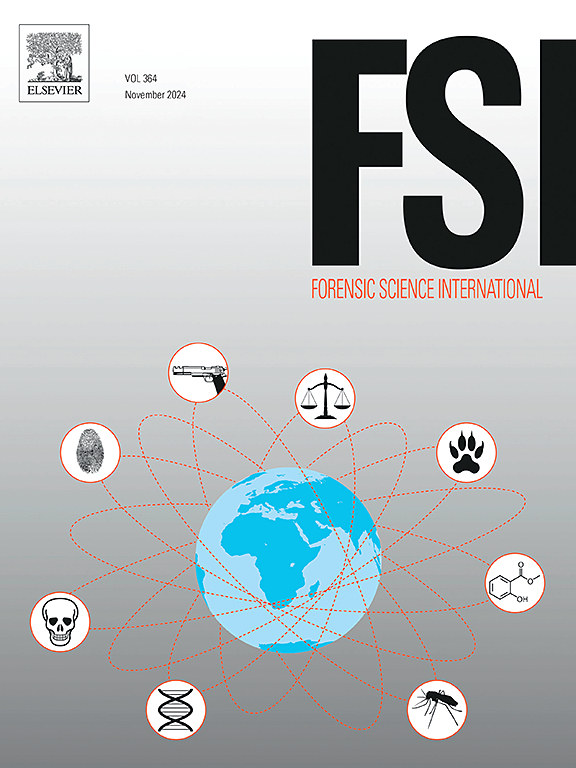Impact of coca leaf flour candy consumption on cocaine and benzoylecgonine levels: The role of hygrine and cuscohygrine in distinguishing licit from illicit cocaine use
IF 2.2
3区 医学
Q1 MEDICINE, LEGAL
引用次数: 0
Abstract
The consumption of coca leaf products, a traditional practice in several Latin American countries, raises forensic challenges in distinguishing legal consumption from illicit cocaine use. This study investigates the implications of consuming coca flour-based candies on drug detection thresholds in oral fluid (OF) and urine for drug-impaired driving (DUID) and workplace drug testing (WDT) contexts. Three commercial candy brands were analyzed, revealing significant variability in coca alkaloid content. Volunteers consumed these candies under controlled conditions, with biological samples collected at various intervals. Key analytes, including cocaine (COC), benzoylecgonine (BE), ecgonine methyl ester (EME), tropococaine (TRO) and cocaethylene (CE), were quantified alongside coca leaf-specific markers (cuscohygrine, cinnamoylcocaine, and hygrine). Analysis was performed using liquid chromatography-tandem mass spectrometry (LC-MS/MS) with multiple reaction monitoring mode (MRM) transitions to ensure specificity.
Results
indicate that coca leaf markers (CUS, HYG) remain detectable after candy consumption, while traditional cocaine markers (COC, BE) exceeded international cutoffs for DUID and WDT in certain cases, particularly following ingestion of high-alkaloid brands. Coca-flour candies with alcoholic beverages produced detectable CE levels but never exceeded the cutoff values of 8 ng/mL in OF or 20 ng/mL in urine required by DUID guidelines. Analyte variability was influenced by candy brand, quantity consumed, and method of ingestion, with oral fluid showing prolonged detection when candies adhered to teeth. These findings emphasize the need to account for legal coca product consumption, as misinterpreted results could unjustly categorize consumers as illicit drug users, requiring nuanced approaches in forensic toxicology.
食用古柯叶面粉糖对可卡因和苯甲酰茶碱水平的影响:碱和碱在区分合法和非法可卡因使用方面的作用
古柯叶产品的消费是若干拉丁美洲国家的一种传统做法,在区分合法消费和非法使用可卡因方面提出了法医挑战。本研究调查了食用古柯面粉糖果对药物受损驾驶(DUID)和工作场所药物测试(WDT)情况下口服液(of)和尿液中药物检测阈值的影响。对三种商业糖果品牌进行了分析,揭示了古柯生物碱含量的显著差异。志愿者在受控条件下食用这些糖果,并在不同的时间间隔收集生物样本。关键分析物,包括可卡因(COC)、苯甲酰茶碱(BE)、茶碱甲酯(EME)、tropococaine (TRO)和可卡因(CE),与古柯叶特异性标记物(cuscohygrine、cinnamoylcocaine和hygrine)一起进行定量。采用液相色谱-串联质谱(LC-MS/MS)进行分析,并采用多反应监测模式(MRM)转换以确保特异性。结果表明,古柯叶标记物(CUS, HYG)在食用糖果后仍然可以检测到,而传统的可卡因标记物(COC, BE)在某些情况下超过了DUID和WDT的国际截止值,特别是在摄入高生物碱品牌后。含酒精饮料的可口可乐糖产生可检测的CE水平,但从未超过DUID指南要求的8 ng/mL或20 ng/mL的临界值。分析物变异性受糖果品牌、食用数量和摄入方法的影响,当糖果粘附在牙齿上时,口服液的检测时间较长。这些发现强调有必要考虑合法的古柯产品消费,因为错误解读的结果可能不公正地将消费者归类为非法吸毒者,需要在法医毒理学中采取细致入微的方法。
本文章由计算机程序翻译,如有差异,请以英文原文为准。
求助全文
约1分钟内获得全文
求助全文
来源期刊

Forensic science international
医学-医学:法
CiteScore
5.00
自引率
9.10%
发文量
285
审稿时长
49 days
期刊介绍:
Forensic Science International is the flagship journal in the prestigious Forensic Science International family, publishing the most innovative, cutting-edge, and influential contributions across the forensic sciences. Fields include: forensic pathology and histochemistry, chemistry, biochemistry and toxicology, biology, serology, odontology, psychiatry, anthropology, digital forensics, the physical sciences, firearms, and document examination, as well as investigations of value to public health in its broadest sense, and the important marginal area where science and medicine interact with the law.
The journal publishes:
Case Reports
Commentaries
Letters to the Editor
Original Research Papers (Regular Papers)
Rapid Communications
Review Articles
Technical Notes.
 求助内容:
求助内容: 应助结果提醒方式:
应助结果提醒方式:


